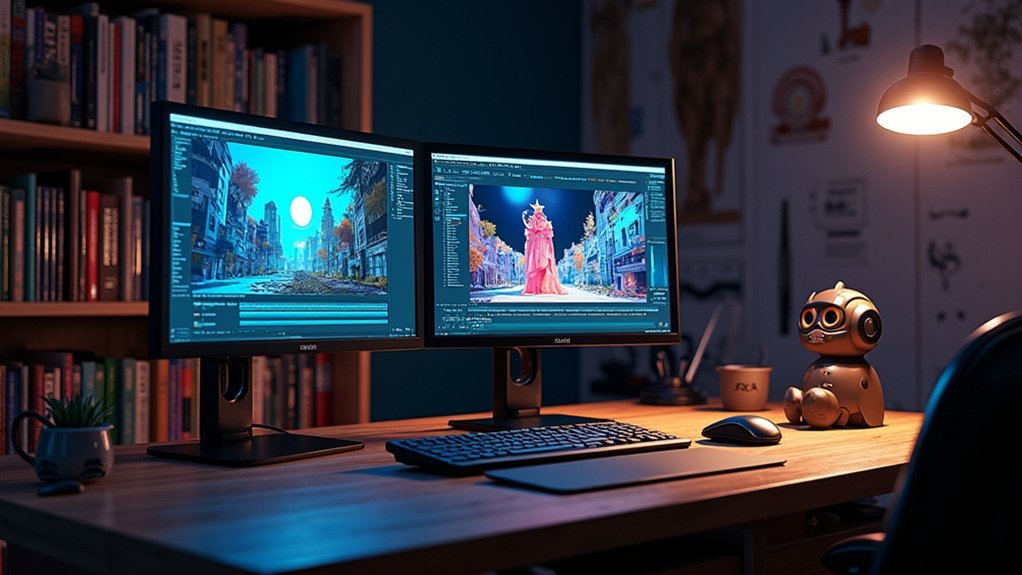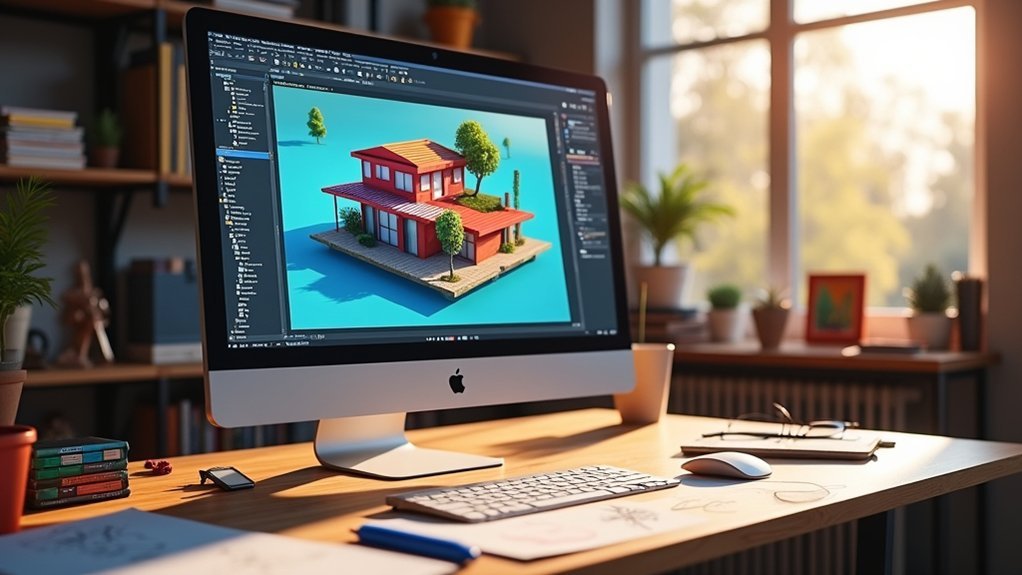The best 3D modeling software with built-in libraries depends on your specific needs. Blender offers extensive free asset collections with professional-grade capabilities, while Autodesk Maya provides industry-standard animation and VFX libraries. SketchUp’s 3D Warehouse integration gives you millions of models, and 3ds Max excels in architectural visualization assets. For engineering, Solidworks delivers manufacturing-ready components, while Marvelous Designer specializes in fabric libraries. Each platform offers unique advantages that’ll help you discover which solution perfectly matches your creative workflow requirements.
What Makes Built-In Libraries Essential for 3D Modeling

Every successful 3D modeling project relies on efficient access to quality assets, and built-in libraries deliver exactly that by providing vast collections of pre-made textures, models, and materials right at your fingertips.
Built-in libraries put professional-grade textures, models, and materials directly at your fingertips, transforming how you access quality 3D assets.
You’ll find these extensive libraries in industry-standard modeling programs like Autodesk 3ds Max and Cinema 4D, where they’re specifically designed to accelerate your workflow and boost productivity.
What makes these libraries truly essential is their customizable nature. You can modify existing assets to match your specific project requirements, dramatically reducing design time while maintaining professional quality.
These resources also guarantee consistency across your projects, letting you establish a uniform style throughout your work.
For beginners, built-in libraries serve as excellent learning tools, demonstrating effective modeling techniques through ready-to-use elements.
Blender: Open-Source Powerhouse With Extensive Asset Collections
Blender stands out as the most compelling free alternative to expensive commercial 3D modeling software, offering professional-grade capabilities without the hefty price tag.
You’ll discover thorough modeling tools that rival industry-standard applications, backed by an extensive library of built-in materials, textures, models, and brushes that accelerate your creative workflow.
The software’s community-driven development guarantees you’re constantly receiving updates and new features. You can tap into user-contributed asset libraries and plugins that expand functionality beyond the core package.
Blender’s Python integration lets you create custom scripts and personalized libraries, automating repetitive tasks to match your specific workflow needs. With support for numerous file formats, you’ll easily collaborate across different platforms and integrate external asset collections seamlessly.
Autodesk Maya: Professional-Grade Libraries for Animation and VFX

You’ll find Maya’s professional libraries packed with industry-standard assets that streamline your animation workflow from day one.
The software’s extensive collection of pre-rigged characters and animation presets lets you jump straight into creating complex movements without building everything from scratch.
Maya’s VFX elements library gives you instant access to particle systems, dynamic simulations, and visual effects that’d typically take hours to develop manually.
Maya’s Asset Library Features
Maya’s extensive asset library transforms how you approach animation and VFX projects by providing thousands of pre-built components at your fingertips.
You’ll find high-quality models, textures, and rigs that streamline your workflow and eliminate repetitive tasks. The customizable assets let you modify existing elements to match your specific project requirements while maintaining visual consistency throughout your work.
Maya’s asset management system organizes and categorizes resources efficiently, making it simple to locate what you need quickly.
You’ll appreciate the broad file format support that guarantees seamless compatibility with external assets and third-party plugins, enhancing collaboration in professional environments.
Regular library updates continuously expand your toolkit with cutting-edge features and assets, keeping your creative capabilities current with industry standards.
Animation Presets and Rigs
Professional animators rely heavily on Maya’s extensive animation presets and rigs to accelerate their creative process and deliver high-quality results efficiently.
You’ll find thorough libraries of pre-built character rigs that eliminate the need to start from scratch, allowing you to focus on creative storytelling rather than technical setup. This animation software excels in character creation through its robust HumanIK system, which enables intuitive rigging and seamless retargeting across different skeletons.
Maya’s animation libraries offer customizable character rigs for both realistic and stylized projects, ensuring flexibility for diverse creative visions.
You can leverage community-created resources and tutorials that enhance your understanding of built-in presets. These advanced tools streamline complex character movements and behaviors, making Maya an industry-standard choice for professional animation workflows.
VFX Elements Collection
Advanced visual effects become achievable through Maya’s extensive VFX Elements Collection, which delivers professional-grade assets that transform ordinary scenes into cinematic experiences.
You’ll access pre-built simulations for smoke, fire, and water that integrate seamlessly into your projects without extensive manual setup. The thorough VFX toolkit streamlines your workflow by providing customizable presets you can adjust to match specific project requirements.
You can create high-quality animations faster while focusing more energy on storytelling rather than technical complexities.
Maya’s particle effects, fluid simulations, and dynamic simulations maintain industry standard quality that keeps your work competitive. Regular library updates guarantee you’re working with current animation trends and cutting-edge visual effects tools, giving you consistent access to professional-grade resources.
Sketchup: User-Friendly Interface With Rich 3D Warehouse Integration

You’ll find SketchUp’s intuitive design interface makes 3D modeling accessible whether you’re a beginner or seasoned professional.
The software’s seamless integration with the 3D Warehouse gives you instant access to millions of free models that can transform your workflow.
This extensive component library lets you quickly import pre-made elements into your projects, dramatically reducing design time while expanding your creative possibilities.
Intuitive Design Interface
Simplicity defines SketchUp’s approach to 3D modeling, with an interface that welcomes both beginners and seasoned designers without overwhelming complexity. The intuitive design interface streamlines your workflow through straightforward tools and logical command placement. You’ll navigate effortlessly between drawing functions and 3D manipulation controls without hunting through complicated menus.
| Feature | Benefit | User Experience |
|---|---|---|
| Drag-and-Drop | Quick model placement | Seamless workflow |
| Search/Filter | Fast asset discovery | Efficient browsing |
| One-Click Import | Instant integration | Streamlined process |
| Community Sharing | Collaborative design | Enhanced creativity |
The 3D Warehouse integration amplifies this simplicity by providing instant access to thousands of pre-made components. You’ll search, filter, and incorporate models directly into your projects without leaving the interface, maintaining creative momentum while building sophisticated designs.
3D Warehouse Access
SketchUp’s 3D Warehouse transforms how you access design resources by putting over 4 million pre-made models at your fingertips.
You’ll navigate this library effortlessly through SketchUp’s intuitive interface, searching and downloading components without technical barriers. The D Warehouse features community-contributed content, giving you diverse styles and designs for architecture, product development, and specialized projects.
You can also contribute by uploading your own 3D models, enhancing the shared library while building your portfolio.
This seamless integration eliminates the need to model every component from scratch, accelerating your workflow considerably. Instead of spending hours creating basic elements, you’ll focus on creative design decisions and project refinement.
The D Warehouse fundamentally becomes your digital inventory, streamlining modeling processes across all project phases.
Component Library Benefits
While many 3D modeling programs overwhelm users with complex menus and scattered resources, SketchUp’s component library streamlines your entire workflow by housing essential building blocks directly within your workspace. The 3D Warehouse integration transforms your design process by providing instant access to thousands of pre-made components, dramatically reducing modeling time and enhancing productivity.
| Benefit | Impact |
|---|---|
| Speed Enhancement | Import ready-made models instantly instead of building from scratch |
| Design Versatility | Access components for architecture, interiors, and product visualization |
| Resource Freshness | Community contributions guarantee constant updates and new additions |
You’ll find specialized components tailored to your specific needs, whether you’re designing buildings, furniture, or consumer products. This rich library guarantees you’re never starting with a blank canvas, making professional-quality results achievable regardless of your experience level.
3ds Max: Comprehensive Asset Management for Architectural Visualization
When architectural visualization projects demand sophisticated asset organization, 3ds Max delivers with its extensive built-in library system that houses materials, textures, and models specifically engineered for architectural workflows.
The Asset Browser transforms your 3D modeling experience by providing intuitive management tools that streamline project development and maintain design consistency.
You’ll benefit from versatile asset management capabilities that support multiple file formats, enabling seamless integration of external resources from third-party libraries.
The software’s collaborative features allow you to create custom asset libraries tailored to specific projects and share them effortlessly with team members.
- Custom Library Creation: Build project-specific asset collections for enhanced workflow efficiency
- Multi-Format Support: Import external assets from various third-party sources without compatibility issues
- Team Collaboration: Share custom libraries across team members for consistent project standards
Cinema 4D: Streamlined Libraries for Motion Graphics and Rendering
Cinema 4D’s extensive asset ecosystem revolutionizes motion graphics workflows through its meticulously curated built-in library that houses materials, models, and animations designed specifically for creative professionals. You’ll find drag-and-drop functionality that seamlessly integrates assets into your scenes, eliminating time-consuming searches for external resources.
| Feature | Benefit | Impact |
|---|---|---|
| Built-in Materials | High-quality textures optimized for rendering | Photorealistic results with minimal setup |
| Drag-Drop Assets | Direct scene integration | Enhanced workflow efficiency |
| Custom Libraries | Personalized collections | Quick access to frequently used assets |
| Regular Updates | Expanded content library | Latest tools and resources |
| Optimized Content | Rendering-specific optimization | Professional-grade output quality |
You can customize and save personal libraries for future 3D modeling projects, while regular updates continuously expand available content for enhanced motion graphics creation.
ZBrush: Specialized Brushes and Materials for Digital Sculpting
You’ll find ZBrush’s brush library stands out with hundreds of specialized tools designed specifically for organic and hard-surface sculpting workflows.
The software’s material presets collection gives you instant access to realistic surface properties that simulate everything from human skin to weathered metal.
These sculpting tool features work together seamlessly, letting you achieve professional-quality results whether you’re creating characters, creatures, or detailed environmental assets.
Brush Library Overview
At the heart of ZBrush’s digital sculpting capabilities lies its extensive Brush Library, which houses hundreds of specialized tools designed to transform your creative vision into detailed 3D models.
This thorough collection streamlines your workflow by providing purpose-built brushes for sculpting, painting, and adding intricate details to your artwork.
The brush library empowers you to create 3D models with unprecedented precision through:
- Task-specific brushes – Dedicated tools for sculpting organic forms, hard surfaces, and fine detailing work
- Customizable parameters – Adjustable size, shape, and dynamics settings to match your artistic style
- Material integration – Seamless compatibility with ZBrush’s materials library for enhanced surface textures
Regular updates continuously expand your creative arsenal, ensuring you’ll always have access to cutting-edge digital sculpting tools.
Material Presets Collection
While ZBrush’s brush library provides the sculpting foundation, the Material Presets Collection elevates your artwork by delivering instant access to hundreds of professionally crafted surface finishes and textures.
You’ll find everything from polished metals and weathered stones to organic skin textures and fabric materials, eliminating time-consuming material setup procedures.
These material presets integrate seamlessly with your sculpting workflow, allowing real-time visualization of surface properties as you work. You can instantly switch between materials to experiment with different looks, helping you make informed creative decisions during the sculpting process.
The customizable interface lets you organize and access your favorite presets efficiently.
You’ll also create and save custom materials, building a personalized library that grows with your artistic needs and project requirements.
Sculpting Tool Features
ZBrush’s specialized brush collection transforms digital sculpting through precision tools designed for specific artistic tasks. You’ll find essential sculpting tool features like Standard, Move, ClayBuildup, and TrimDynamic brushes that deliver diverse effects and intricate details effortlessly.
The software’s customization options let you adjust brush parameters including size, intensity, and texture, creating a personalized creation tool experience for your projects.
- Dynamic Subdivision Levels – Increase polygon counts without performance penalties, maintaining smooth workflow while adding complex details
- Spotlight Integration – Project reference images directly onto sculptures for accurate detailing and precise texture mapping
- Material Library – Apply realistic surface textures like skin, metal, and fabric to achieve professional finishes
These sculpting tool features combine to create an unmatched digital sculpting environment that adapts to your artistic vision.
Rhino3d: Precision Modeling With Engineering-Focused Asset Libraries
When precision matters most in your engineering projects, Rhino3D delivers unparalleled accuracy through its advanced NURBS technology, creating mathematically perfect surfaces that meet the exacting standards of professional design work.
You’ll find precision modeling becomes effortless with Rhino3D’s sophisticated toolset that transforms complex geometries into smooth, accurate representations.
The software’s engineering-focused asset libraries provide immediate access to materials, textures, and components specifically curated for professional applications.
You can expand functionality through specialized plugins tailored for architecture, industrial design, and product development.
The robust community library enables you to share and download custom assets, fostering collaboration among users.
These libraries integrate seamlessly with modeling tools, ensuring efficient workflow and quick resource access throughout your design process.
Houdini: Procedural Asset Creation With Node-Based Library System
Through its revolutionary node-based workflow, Houdini transforms how you approach procedural asset creation by connecting operational nodes that represent different parameters and functions in your design process.
This procedural modeling software empowers you with non-destructive editing capabilities, allowing modifications at any stage without losing previous work.
Houdini’s extensive built-in library accelerates your workflow by providing:
- Pre-built assets and tools for rapid prototyping and iteration
- Seamless asset management for combining multiple library components
- Enhanced team collaboration through standardized procedural workflows
You’ll benefit from Python scripting support that extends library functionality to match your specific project requirements.
The software’s procedural approach guarantees you can customize and integrate tools with existing workflows, making it an invaluable asset for complex 3D modeling projects requiring precision and flexibility.
Solidworks: Manufacturing-Ready Components and Assembly Libraries
Unlike purely artistic 3D modeling tools, Solidworks delivers manufacturing-focused libraries packed with industry-standard components that accelerate your engineering workflow from concept to production. You’ll access extensive collections of screws, bolts, and fasteners that integrate seamlessly into your designs, eliminating time-consuming modeling of standard parts.
| Feature | Benefit |
|---|---|
| Industry Standards Support | Guarantees safety and performance compliance |
| Custom Library Creation | Enables project-specific component reuse |
| Automatic Updates | Maintains latest specifications |
| Assembly Drawing Generation | Streamlines documentation process |
| Manufacturing-Ready Components | Accelerates production timeline |
These manufacturing-ready components and assembly libraries transform your design process by providing verified parts that meet industry specifications. You can create custom libraries for specific projects, guaranteeing consistency across multiple designs while reducing errors in production documentation.
Marvelous Designer: Fabric and Clothing Asset Collections
Marvelous Designer’s extensive fabric and clothing asset collections provide fashion designers and 3D artists with an immediate foundation for creating realistic garments without starting from scratch.
You’ll access thorough libraries containing pre-made patterns, textures, and clothing templates that streamline your 3D modeling workflow. These fabric and clothing assets enable rapid prototyping and visualization in three-dimensional space, greatly reducing development time.
The software’s built-in collections offer several advantages:
- Realistic fabric simulations that enhance visual fidelity in animations and renderings
- Customizable clothing assets allowing modification to meet specific project requirements
- Regular library updates ensuring access to current fashion trends and industry styles
You can leverage these resources to create unique designs while maintaining professional standards.
The thorough asset library supports both beginner and advanced users in producing high-quality garment visualizations efficiently.
Comparing Library Features Across Different Software Platforms
While Marvelous Designer excels in fabric-specific asset collections, other 3D modeling platforms offer distinct library advantages tailored to different creative workflows.
Autodesk 3ds Max provides extensive built-in libraries with materials, textures, and models for architectural and animation projects.
Autodesk 3ds Max delivers comprehensive asset libraries featuring materials, textures, and models optimized for architectural visualization and animation workflows.
Cinema 4D’s thorough content browser streamlines motion graphics work with pre-made assets that enhance visualization efficiency.
Blender’s robust asset management system lets you create custom libraries for materials and models, supporting seamless project reuse.
Rhino3D includes standard shapes while accommodating third-party plugins for complex design requirements.
Solidworks focuses on engineering workflows with built-in component libraries for manufacturing projects.
Each platform’s library features align with specific industry needs, making your software choice dependent on project requirements and creative objectives.
Choosing the Right Software Based on Your Library Needs
How do you determine which 3D modeling software aligns best with your library requirements? Start by evaluating your project scope and skill level. If you’re a beginner seeking quick solutions, SketchUp’s extensive user-generated libraries offer immediate access to pre-made models.
For architectural visualization demanding realistic renders, 3ds Max’s robust material libraries excel at creating professional results.
Consider these key factors when selecting design software:
- Project type – Motion graphics artists benefit from Cinema 4D’s integrated content library, while general modeling favors Blender’s community assets.
- Budget constraints – Blender provides free add-ons and libraries, making it cost-effective for budget-conscious users.
- Workflow efficiency – Built-in libraries should complement your existing processes without creating unnecessary complexity.
Match your specific needs with each platform’s library strengths for ideal results.
Frequently Asked Questions
What Is the Best 3D Model Library?
You’ll find SketchUp’s 3D Warehouse offers the most extensive free library with millions of user-generated models. It’s easily accessible, constantly updated, and covers everything from furniture to complex architectural elements for your projects.
What Is the Most Used Software for 3D Modeling?
You’ll find Blender’s the most widely used 3D modeling software globally due to its free, open-source nature and extensive features. Maya dominates professional animation studios, while 3ds Max leads in architectural visualization and game development.
What Is the Best Open-Source 3D Modeling Software?
You’ll find Blender is the best open-source 3D modeling software available. It’s completely free, offers professional-grade tools, has excellent community support, and includes built-in materials plus Python scripting capabilities for customization.
Which System Is Best for 3D Modeling?
You’ll find the best 3D modeling system depends on your specific needs. Blender excels for general modeling, Solidworks dominates engineering, Cinema 4D leads motion graphics, while SketchUp offers simplicity and collaboration features.





Leave a Reply